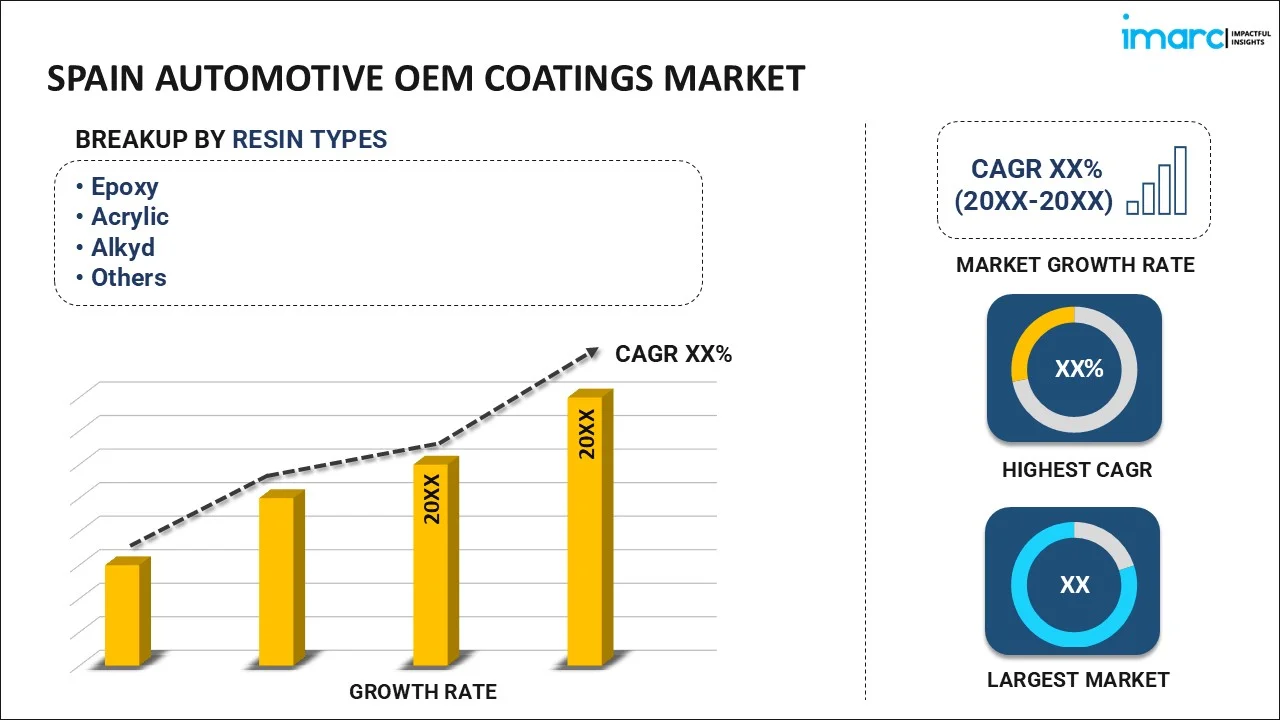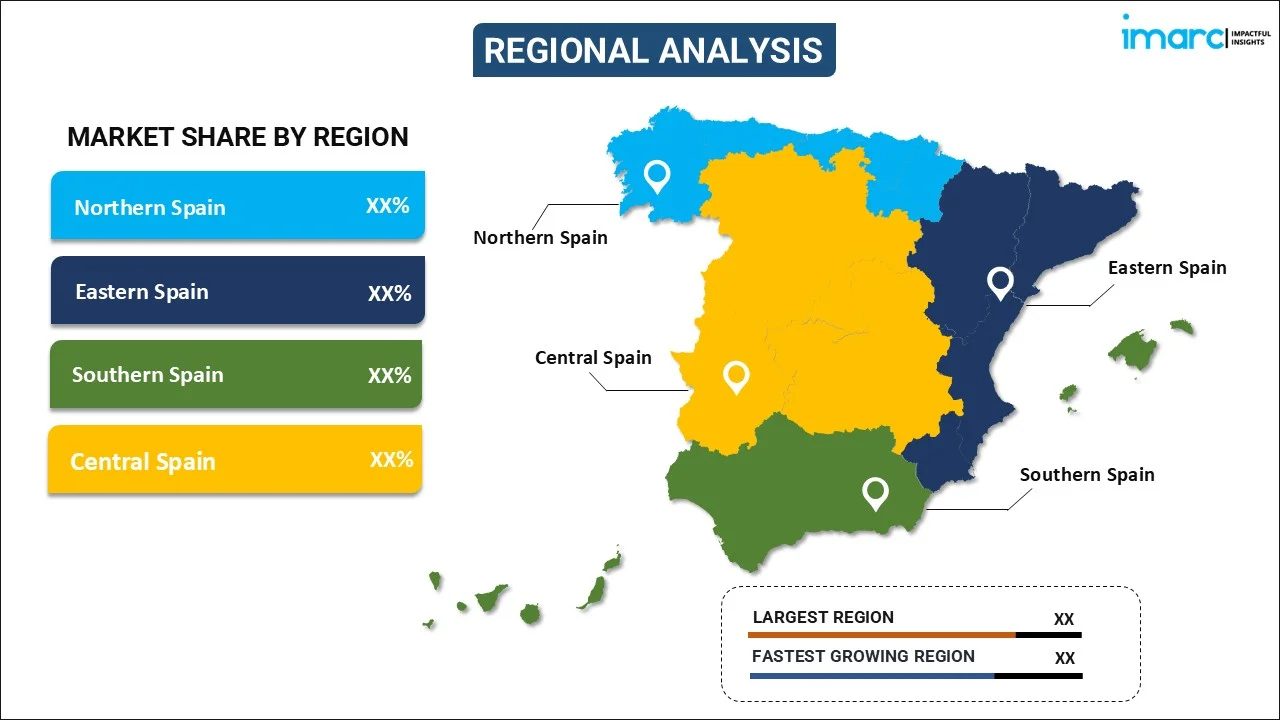
Spain Automotive OEM Coatings Market Size, Share, Trends and Forecast by Resin Type, Technology, Application, and Region, 2025-2033
Spain Automotive OEM Coatings Market Overview:
The Spain automotive OEM coatings market size reached USD 130.40 Million in 2024. Looking forward, IMARC Group expects the market to reach USD 226.33 Million by 2033, exhibiting a growth rate (CAGR) of 5.80% during 2025-2033. The market is expanding due to rising vehicle production, increasing demand for sustainable coatings, and stringent environmental regulations. Factors such as advancements in coating technology, growing electric vehicle (EV) adoption, and rising investments in automotive manufacturing facilities further contribute to market growth, driving innovation and sustainability.
|
Report Attribute
|
Key Statistics
|
|---|---|
|
Base Year
|
2024 |
|
Forecast Years
|
2025-2033
|
|
Historical Years
|
2019-2024
|
| Market Size in 2024 | USD 130.40 Million |
| Market Forecast in 2033 | USD 226.33 Million |
| Market Growth Rate (2025-2033) | 5.80% |
Spain Automotive OEM Coatings Market Trends:
Increasing Demand for Sustainable and Low-VOC Coatings
The automotive OEM coatings industry in Spain is witnessing a significant shift towards low-VOC (volatile organic compound) and waterborne coatings, driven by stringent European Union (EU) environmental regulations. As manufacturers strive for eco-friendly solutions, solvent-free and high-solid coatings are gaining traction due to their lower emissions, improved durability, and reduced energy consumption during application. The adoption of bio-based resins and UV-curable coatings is also expanding, offering enhanced adhesion, corrosion resistance, and longevity. OEMs are increasingly collaborating with coatings manufacturers to develop lightweight, high-performance coatings that align with sustainability goals. This trend is reinforced by automotive brands seeking compliance with carbon neutrality targets, further accelerating R&D in green coatings within Spain's automotive sector. For instance, in March 2025, BASF launched Ultrason® E 2010 BMB, the world's first biomass-balanced polyethersulfone (PESU), replacing fossil feedstock with renewable alternatives. Certified under ISCC PLUS, this drop-in solution offers the same performance and certifications as standard PESU, supporting sustainability goals across industries like automotive, electronics, and healthcare. Manufactured using green electricity, it reduces product carbon footprint while enabling customers to maintain existing processing lines.
Growth of Electric Vehicle (EV) Manufacturing and Specialty Coatings
The expansion of Spain’s EV sector is reshaping demand for advanced automotive coatings, particularly in heat-resistant, insulating, and high-gloss coatings. For instance, as per industry reports, by May 2024, 41,474 electrified vehicles were registered in Spain, up 1.2% year-over-year. In line with this, the country has 29,301 charging points, with 11,173 installed in 2023. The government plans a €1.25 billion EV funding initiative, while automakers push low-cost EV models to accelerate adoption. EV battery enclosures require coatings with thermal management properties, while lightweight materials such as aluminum and composites demand specialized coatings for enhanced adhesion and durability. Additionally, self-healing coatings and anti-scratch finishes are becoming essential to maintain vehicle aesthetics and longevity. Leading automotive manufacturers are investing in customized coatings for EV components, including battery housings, chassis, and charging ports, to ensure superior protection against corrosion and wear. With Spain emerging as a European hub for EV production, the demand for high-performance and functional coatings is expected to rise significantly in the coming years.
Advancements in Smart Coatings and Digital Color Customization
The integration of smart coatings with self-cleaning, anti-fingerprint, and temperature-responsive properties is transforming Spain’s automotive OEM coatings market. Nanotechnology-based coatings are gaining prominence, offering enhanced hydrophobicity, UV resistance, and improved surface durability. In addition, digital color customization technologies are revolutionizing vehicle aesthetics, enabling automakers to offer personalized coatings with color-shifting effects and rapid color changes. These advancements cater to the growing consumer preference for unique and customizable vehicle designs. AI-driven paint application systems are also being deployed in automotive assembly lines, ensuring precision, efficiency, and minimal waste. As automotive manufacturers embrace digitalization, the adoption of smart coatings and digital color innovations is expected to drive new opportunities in Spain’s OEM coatings market. For instance, in June 2023, BASF Española inaugurated its Technology Competence Center in Marchamalo, Spain, to enhance automotive coating solutions. The €14 million facility supports over 100 factories worldwide, replicating vehicle painting processes under varied conditions. It integrates Industry 4.0 digital connectivity and strengthens BASF’s strategy for solvent-borne basecoats. The center also prioritizes sustainability with energy-efficient equipment.
Spain Automotive OEM Coatings Market Segmentation:
IMARC Group provides an analysis of the key trends in each segment of the market, along with forecasts at the region/country level for 2025-2033. Our report has categorized the market based on resin type, technology, and application.
Resin Type Insights:

- Epoxy
- Acrylic
- Alkyd
- Polyurethane
- Polyester
- Others
A detailed breakup and analysis of the market based on the resin type have been provided in the report. This includes epoxy, acrylic, alkyd, polyurethane, polyester, and others.
Technology Insights:
- Water-Borne
- Solvent-Borne
- Others
A detailed breakup and analysis of the market based on technology have also been provided in the report. This includes water-borne, solvent-borne, and others.
Application Insights:
- Passenger Cars
- Commercial Vehicles
- ACE
A detailed breakup and analysis of the market based on the application have also been provided in the report. This includes passenger cars, commercial vehicles, and ACE.
Regional Insights:

- Northern Spain
- Eastern Spain
- Southern Spain
- Central Spain
The report has also provided a comprehensive analysis of all the major regional markets, which include Northern, Eastern, Southern, and Central Spain.
Competitive Landscape:
The market research report has also provided a comprehensive analysis of the competitive landscape. Competitive analysis such as market structure, key player positioning, top winning strategies, competitive dashboard, and company evaluation quadrant has been covered in the report. Also, detailed profiles of all major companies have been provided.
Spain Automotive OEM Coatings Market News:
- In January 2025, JLR invested £65 million (USD 81.2 Million) to expand its luxury paint facilities in the UK and Europe to meet rising demand for vehicle personalization. The £41M (USD 59.2Million) Castle Bromwich upgrade will enhance SVO paint operations, while £24M (USD 29.9 Million) in Nitra, Slovakia will add a new electric paint line, creating 120 jobs. The initiative aligns with JLR’s net-zero strategy by reducing paint shop emissions, which account for 80% of operational emissions.
- In June 2024, Spanish manufacturer Briolf Group invested USD 30.5 Million to establish its first U.S. plant in Monroe, North Carolina, creating 100 jobs. The facility will primarily produce automotive refinishing and industrial coatings through its Roberlo subsidiary and later expand to other Briolf companies.
Spain Automotive OEM Coatings Market Report Coverage:
| Report Features | Details |
|---|---|
| Base Year of the Analysis | 2024 |
| Historical Period | 2019-2024 |
| Forecast Period | 2025-2033 |
| Units | Million USD |
| Scope of the Report |
Exploration of Historical Trends and Market Outlook, Industry Catalysts and Challenges, Segment-Wise Historical and Future Market Assessment:
|
| Resin Types Covered | Epoxy, Acrylic, Alkyd, Polyurethane, Polyester, Others |
| Technologies Covered | Water-Borne, Solvent-Borne, Others |
| Applications Covered | Passenger Cars, Commercial Vehicles, ACE |
| Regions Covered | Northern Spain, Eastern Spain, Southern Spain, Central Spain |
| Customization Scope | 10% Free Customization |
| Post-Sale Analyst Support | 10-12 Weeks |
| Delivery Format | PDF and Excel through Email (We can also provide the editable version of the report in PPT/Word format on special request) |
Key Questions Answered in This Report:
- How has the Spain automotive OEM coatings market performed so far and how will it perform in the coming years?
- What is the breakup of the Spain automotive OEM coatings market on the basis of resin type?
- What is the breakup of the Spain automotive OEM coatings market on the basis of technology?
- What is the breakup of the Spain automotive OEM coatings market on the basis of application?
- What are the various stages in the value chain of the Spain automotive OEM coatings market?
- What are the key driving factors and challenges in the Spain automotive OEM coatings market?
- What is the structure of the Spain automotive OEM coatings market and who are the key players?
- What is the degree of competition in the Spain automotive OEM coatings market?
Key Benefits for Stakeholders:
- IMARC’s industry report offers a comprehensive quantitative analysis of various market segments, historical and current market trends, market forecasts, and dynamics of the Spain automotive OEM coatings market from 2019-2033.
- The research report provides the latest information on the market drivers, challenges, and opportunities in the Spain automotive OEM coatings market.
- Porter's Five Forces analysis assist stakeholders in assessing the impact of new entrants, competitive rivalry, supplier power, buyer power, and the threat of substitution. It helps stakeholders to analyze the level of competition within the Spain automotive OEM coatings industry and its attractiveness.
- Competitive landscape allows stakeholders to understand their competitive environment and provides an insight into the current positions of key players in the market.
Need more help?
- Speak to our experienced analysts for insights on the current market scenarios.
- Include additional segments and countries to customize the report as per your requirement.
- Gain an unparalleled competitive advantage in your domain by understanding how to utilize the report and positively impacting your operations and revenue.
- For further assistance, please connect with our analysts.
 Inquire Before Buying
Inquire Before Buying
 Speak to an Analyst
Speak to an Analyst
 Request Brochure
Request Brochure
 Request Customization
Request Customization




.webp)




.webp)












